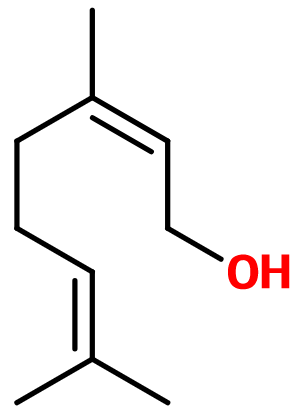
Photo credits: ScenTree SAS
| Company | Ingredient Name | ID | Comments | Naturality | Certifications | Purity | Latin name | Treated part | Geographical origin | MOQ |
|---|---|---|---|---|---|---|---|---|---|---|
|
|
Nerol | 30646389 |
Visit website
|
Molecule | - | - | - | - | - |
General Presentation
-
CAS N° : 106-25-2
-
EINECS number : 203-378-7
-
FEMA number : 2770
-
FLAVIS number : 02.058
-
JECFA number : 1224
-
Appearance : Colorless liquid
-
Density : 0,877
-
Volatility : Heart
-
Price Range : €€
Physico-chemical properties
-
Molecular formula : C10H18O
-
Molecular Weight : 154,25 g/mol
-
Log P : 2,75
-
Fusion Point : Donnée indisponible.
-
Boiling Point : 104°C (à 9 mmHg)
-
Detection Threshold : Donnée indisponible.
-
Optical rotation : Donnée indisponible
-
Vapor pressure : Donnée indisponible
-
Refractive Index @20°C : Donnée indisponible
-
Acid Value : Donnée indisponible.
-
Flash Point : 99°C
Uses
Uses in perfumery :
Nerol is used in rose, geranium, orange blossom and verbena notes.
Year of discovery :
Data not available.
Natural availability :
Nerol is present in many natural products, often accompanied by Geraniol. It also owes its name to its presence in the Neroli EO. It can also be extracted from Clary Sage EO and Lemongrass EO, in which it is present up to 6%.
Isomerism :
Nerol is a diastereoisomer of Geraniol. The trans isomer of 3,7-dimethylocta-2,6-dien-1-ol is Geraniol, when the cis isomer is Nerol. The smell of nerol is closer to Neroli EO or Magnolia Flower EO when geraniol is more citraly and close to Geranium EO. Both molecules remain classics of the rose alcohol family, and both are present in the mixture of molecules called Rhodinol 70. Linalool and Eucalyptol are examples of constitutional isomers of Nerol. Linalool has a floral note, different from Nerol, and Eucalyptol, like other isomers, is radically different from Nerol.
Synthesis precursor :
Nerol is a precursor to the synthesis of the same molecules as geraniol, as these two molecules are stereoisomers of each other. It is involved in the synthesis of Citronellal, Citral, Cyclonerol, Dihydronerol and Tetrahydrogeraniol. Nerol, however, tends to cyclize more easily in the presence of an acid.
Synthesis route :
Nerol is separated from Geraniol at the end of its synthesis from Myrcene. Pyrolysis of beta-Pinene allows to obtain Myrcene, which is converted into geranyl, neryl and linalyl chloride by the addition of hydrochloric acid (catalysed by copper chloride I and a quaternary ammonium salt, for example). The reaction of these intermediates with sodium acetate, followed by saponification of the obtained esters, allows to obtain the alcohols separated by distillation.
Regulations & IFRA
Allergens :
This ingredient does not contain any allergen.
IFRA 51th :
This ingredient is not restricted for the 51th amendment


